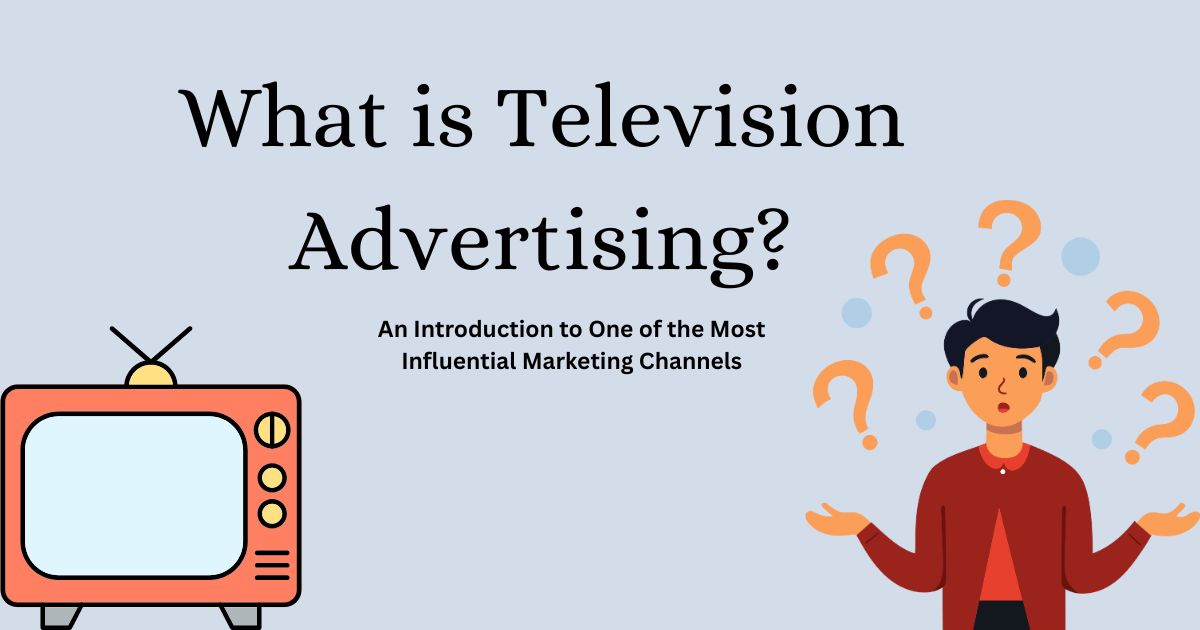It’s a fact, TV advertising is one of the most influential media for promoting products and brands today. Despite the proliferation of digital marketing and streaming services, TV commercials still seem to resonate with millions of viewers and translate to considerable brand awareness and sales. But what is television advertising, and how can businesses use it to their full advantage?
Television advertising is advertising on television, where the television programs stop and resume normal work, so that people can watch the commercials advertising between the pause in the program. They air in between content as commercials, and are meant to grab the attention of the viewer, express particular messages, and urge certain behavior. From 30-second prime-time commercials to lengthy infomercials, TV advertising comes in many forms.
This complete guide will discuss everything about TV ads, from the basics to the advanced targeting techniques behind them. You are also going to learn how TV ad works, types of commercials, costs, and measurement ratios, and tips on how to get maximum ROI from TV advertising.
How Television Advertising Works
Advertising as it is practiced on television is a simple, but subtle, business. Companies buy airtime on TV networks or stations to air their ads, the commercials air during particular television programs or blocks of time. The funnel consists of various important elements and stakeholders interacting with each other to successfully channelize the ads to the targeted recipients.
The Television Advertising Ecosystem
Networks and stations sell classes of advertising time to agencies and advertisers. Media buyers get the best rates, the most valuable time slots and handle the mechanics of the campaign. Production companies produce the ads themselves, measurement firms track viewership and the performance of campaigns.
Most advertisers work with agencies who reside in the space of media planning and buying. These are organizations that have relationships with networks, are able to negotiate favorable rates and also offer all sorts of help with campaign optimization advice.
Broadcast vs. Cable vs. Streaming
Legacy broadcast TV refers to the traditional channels of the major networks including ABC, CBS, NBC, and Fox. These networks have wide audiences, but ad spots can come at a higher cost.
Cable provides more narrow-casting opportunities with niche channels. And networks such as CNN, ESPN and Food Network draw certain demographic groups that advertisers can use to reach more targeted audiences.
Up has been streaming television advertising. Platforms like Hulu, Roku and Amazon Prime Video give advertisers access to cord-cutters and other people under age 35 who watch less traditional TV.
Types of Television Advertising

Traditional Commercial Spots
Commercial lengths vary between 15 and 60 seconds, with 30-second commercials being the most typical. These are the spots that are slotted in between programming naturally and are the bread and butter of television advertising.
Simple and basic messages, reminders and theast_01_06_26e like-for-like direct response or C2 (clickto- response) are best for 15 second commercials. They are cheaper than longer spots, but they don’t afford a lot of time for complex stories.
And 60-second commercials provide room for more nuanced messaging and emotional storytelling. They’re especially useful for new product introductions, complicated services or brand-building campaigns.
Infomercials
Infomercials are commercials that are longer than the usual commercial you see on television, but shorter than a movie or other program you would watch. Their time long presentations are designed to showcase products, show testimonials and even overcome objections.
These extended formats in particular work well for explanatory or demonstrative products. Infomercial types work well for kitchen appliances, fitness equipment and educational products.
Sponsorships and Branded Content
Program sponsorships are the opportunity for your brand to be associated with specific shows or segments. It’s the brand exposure medium through repetition of positive associations with good content.
Native advertising is when advertising messages are woven into the programming. Product integrations, sponsored content, and brand integrations create non-intrusive ads.
Local vs. National Advertising
National tv advertising enables the message to reach an entire country across all networks. They’re usually baked with large budgets yet again the reach and exposure they usually guarantee is enormous.
spot advertising Advertising on the local TV level through local stations and cable systems. This enables smaller businesses to advertise on television at lower costs and still target audiences in their local area.
Television Advertising Costs and Budgeting
Factors Affecting Television Advertising Costs
Television Advertising Costs Are a Result of Several Factors. Pricing is also heavily influenced by time slots, with an order of magnitude higher price for prime time (8-11 PM).
The popularity of a program has a direct effect on how much advertising is sold. Even hit series with large audience share command top dollar for commercial time. Price Profiling Seasonal changes also affect pricing, price is often higher during holiday seasons and other major events.
Distance also drives cost. National Tongue Tags are considerably more expensive than advertising locally or regionally. The size of the local advertising market will also influence these prices, generally the larger the metropolitan area the more you can charge.
Cost Structures
TV Ads cost TV ads usually include production costs and ad buy price. Costs vary greatly according to commercial complication, talent needs and production values.
Media buying fees vary based on the above. Prices are usually based on cost per thousand impressions (CPM) or the price you pay for 1,000 viewers.
Budgeting Strategies
AdPlanIt TV Find Your Audience with TV | Target Consumers Jump to Why us? Spending a TV Advertising Budget — TV Advertising Budgeting: Plan Carefully & Don’t Expect Too Much 2019-08-20 21:40:45 4 0 0 For starters, advertisers should know that spending a TV advertising budget needs careful planning and realistic expectations. First, decide on your target audience and the optimal reach frequency. What is the lowest budget required to get a substantial reach?
Think about the cost of production at the planning stage. Good quality commercials cost money to produce professionally, and that budget is typically 10-20% of your total TV advertising spend.
Plan for testing and optimization. Good TV advertising campaigns need more than one creative and continuous optimization in the light of the performance figures.
Measuring Television Advertising Effectiveness

Traditional Metrics
Television ad measurement has come a long way in recent years. Conventional measures include reach (how many people see your ad) and frequency (how many times they see it).
The single most or number two thing companies should measure their campaigns on (1)?; – A measurement that ignores the campaign’s role in driving sales (87); – An indicator so outdated, it isn’t worth the fiber it’s printed on (109); – A metric that cares not if you run ads as the world burns, so long as your content reaches the same number of targets (30); – A sad sight that brings a tear to the eye of even the dispassionate direct marketer (56)??-···?-? – A measure of campaign exposure that multiplies Reach and Frequency to show how much a campaign really cost. GRPs allow advertisers to make comparisons between various media plans and maximize their investments in television advertising.
Modern Measurement Approaches
Sophistication of measurement has now added new dimensions for the measurement of TV advertising effectiveness. Set-top box data provides rich viewing behavior and demography data.
Attribution modeling attributes TV ad exposures to actual business results. These models monitor how television commercials are influencing website visits, phone calls, and sales conversion.
Integration with Digital Marketing
Traditional television commercials measurement is ever more associated with digital advertising(3). Measure TV to online cross platform attribution of ad exposure to consumer behaviors and conversions.
Social Media monitoring in television Ad campaigns offers insight on real-time audience reaction and engagement levels.
Advertising in Television: Perceived Targeting and Audience Segmentation
Demographic Targeting
Television advertisements can be targeted demographically and be quite sophisticated. Advertisers have the opportunity to target potential customers according to age, sex, income, education and household type.
Geographic targeting permits businesses to concentrate their television ads in particular areas, cities, or even neighborhoods. This accuracy allows the format to ensure relevancy and minimize wasted impressions.
Psychographic and Behavioral Targeting
Advanced targeting involves more than just demographics, it looks at psychographic and behavioral. Lifestyle, preferences and interests and viewing habits are all considerations for targeting choices.
Daypart targeting delivers ads to time slots when a target demographic is sure to be watching. Morning and late-night audiences are different.
Programmatic Television Advertising
Programmatic television advertising eliminates the need for human negotiations, and allows more pinpoint targeting. That way advertisers can buy the audience that they want to reach rather than largely buying the program.
Dynamic bidding and purchasing of TV ads in real time 1 drives cost efficiencies and smarter targeting capabilities. They can change their tactics based on how well the ads are doing, as well as conditions in the market.
Television Commercial Tips and Best Practices for Creatives
Storytelling Principles
Great TV commercials come from great tales well told. Compelling narratives resonate with audience and generate lasting brand experiences.
Those first few seconds of TV commercials are really important. Effective commercials grab the attention of viewers right from the get-go and keep them engaged for the duration of the spot.
Visual and Audio Elements
Television Advertising: Visual and Audio Features in Ads Produce a Compelling Message prefs/149_av_05.pdf 3 Television Advertising: Visual and Audio Features in Ads Produce a Compelling Message? Quality graphics will add to your credibility and professionalism.
Audio factors such as music, sound effects and voiceovers all contribute to the effectiveness of advertisements. The perfect sounds make for a better kind of connection for emotion and message memory.
Call-to-Action Strategies
Having strong, explicit calls-to-action is what channels viewer response from TV adverts. Effective CTAs are specific, urgent, and easy to follow.
Options and disjunctive choices enhance the effectiveness of television advertising. Including phone numbers, websites and social media handles appeals to various viewer sensibilities.
Television Advertising in the United States: Developments and Prospects
Addressable Television Advertising
Addressable television advertising sends different commercials to different households watching the same show. This technology offers the possibility of household-level targeting and individualized content.
This method greatly enhances the efficiency of television advertising, minimizes wasted impressions, and maximizes compatibility of the message.
Interactive Television Advertising
Interactive TV commercials allow viewers to interact directly with advertisements using their remote controls or other device. Greater engagement and instant feedback opportunities are provided with these formats.
Use QR codes and connect to social media for the link between TV advertising and digital experiences and have a two way interaction.
Artificial Intelligence and Machine Learning
Television advertising campaigns are being optimized more and more with AI and machine learning. They use these techniques to analyze large sets of data to drive better targeting, creative optimization and budgeting.
Predictive analytics: Advertisers can predict audience behavior and tune their TV ad strategies from it.
Getting Started with Television Advertising
Planning Your First Campaign
TV advertising done right starts with a definite goal and defined audience. Decide what you want to accomplish and who needs to hear that.
What does your target market watch on TV? Knowing when and exactly what your viewer is watching allows you to maximize your TV ad spend.
Working with Professionals
Television advertising requires specialized expertise. Open yourself to cooperation with such specialized advertising agencies, to media buyers and to production companies.
Professional advice can prevent common mistakes, as well as maximizing your TV advertising ROI. Television advertising is complicated and even seasoned TV advertising pros need help, so make sure you utilize the full support available for new advertisers.
Testing and Optimization
Begin with smaller, more targeted campaigns to experiment with your television advertising strategy. Collect performance data and tweak your strategy before you scale.
Optimization that never stops – optimizing based on actual performance makes TV advertising more effective with every new flight. Frequent monitoring and updates are the best way to get the most return on investment.
Maximizing Your Television Advertising Investment
Advantages of TV Advertising While digital advertising growth is rapidly expanding, TV advertising still provides many benefits for companies looking to establish brand recognition, get in front of a large audience and make sales. “The winning formula involves having a roadmap, good creative and ongoing optimization.
The TV ad terrain is ever-changing, influenced by emerging technologies and viewing patterns. It is crucial to stay in line with trends, and best practice in terms of not losing your competitive advantage.
When planning your first or next television advertising campaign, make sure to keep clear objectives, a knowledge of your target audience, and the ability to measure back results as the core of your strategy. Television advertising is still a viable option for companies prepared to invest in professional, targeted campaigns.
Begin by learning where your audience is watching, and consider affordable solutions such as local TV advertising or streaming network ads. Professional advice can save you time and effort as well as help you get the most out of your television advertising.
From understanding what television advertising can do for your brand to exploring how business process automation can boost efficiency, modern marketing thrives on both visibility and streamlined operations.





